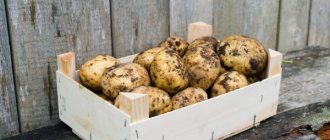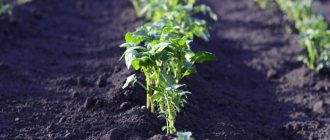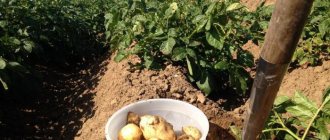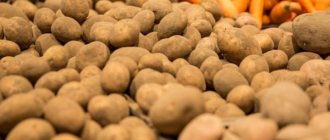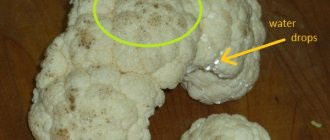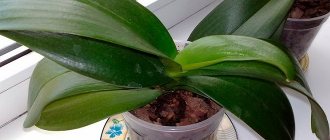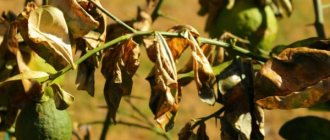Pests
Colorado potato beetle
A permanent and most dangerous pest of potatoes. It also damages eggplants, peppers, and tomatoes.
The beetles are ovoid, convex above, flat below. There are 10 black stripes on the elytra. The length of the beetle is 7 mm. The larvae are worm-shaped, orange-red with a black head and two rows of black dots on the sides. The length of the larva is up to 16 mm.
The beetle develops in two generations per year. The beetles overwinter in the soil at a depth of 20–80 cm, mainly in areas that have grown under potatoes and tomatoes. In spring, beetles appear on the soil surface with the emergence of potato seedlings. The emergence of beetles from their overwintering sites is not amicable: beetles that overwintered closer to the surface emerge earlier. In this regard, the laying of eggs and the hatching of larvae extends over a long period. Some beetles remain in the soil until the spring of next year.
At first, the beetles stay under lumps of soil, at the base of plants, crawling out onto the leaves only in the warm time of the day, and feed sluggishly. As the temperature rises, the beetles feed more intensely, mating and egg laying occur. In search of food plants, beetles can fly long distances. Females lay eggs on the underside of leaves. One clutch can contain up to 60-70 eggs. The orange-yellow eggs against the green background of the leaf are clearly visible, making them easy to collect and destroy. The female's fertility is up to 600 eggs.
The development of the egg, depending on the air temperature, lasts from 5 to 17 days. The larvae develop for about a month. Then they go into the soil, where they pupate at a depth of 5-15 cm. The pupal stage lasts 6-15 days. Young beetles emerge from the soil with weak, lighter integuments. They immediately begin feeding, mating and laying eggs. The second generation beetles go to winter.
Beetles, especially larvae, are voracious. They eat leaves entirely, leaving only thick veins and bare stems. In our area, in particular in the Rostov region, the Colorado potato beetle is a new species. There are no parasites or predators in nature yet that would restrain its reproduction. This explains the high population of the Colorado potato beetle.
Control measures. Regular manual collection of beetles, eggs and larvae with their subsequent destruction. The effectiveness of manual collection of insects is higher during the warm hours of the day, when beetles and larvae are on the plants. Spraying potatoes in the spring when 2-3rd instar larvae (2-3 mm in length) appear and again after 8-12 days. Two sprays are carried out against beetles and second-generation larvae. The following preparations are used for spraying: karate, sherpa, fuori, sumi-alpha, arrivo or kinmiks. Among biological products, bitoxybacillin is recommended during the period of mass hatching of beetle larvae of the first and second generations. Spraying twice, with an interval of 6-8 days. The effectiveness of bitoxibacillin increases at air temperatures of +20° C and above.
Potato stem nematode
A nematode is a worm 1-1.3 mm long. Damages above-ground parts and tubers of potatoes. Less harmful to peas, carrots, tomatoes and other plants. Lives on thistle, dandelion, nightshade.
The source of infection is planting material. From infected planted tubers, the nematode moves into the stems and then into young tubers. Each female lays up to 250 eggs. Signs of infection: shortened and thickened stem, small corrugated leaves. Gray spots appear on infected tubers, the tissue darkens, the skin peels off, and the flesh becomes rotten. In storage, the nematode moves from infected tubers to healthy ones. Mechanical damage to the tuber facilitates the penetration of the nematode into it. Increased temperature and humidity favor the reproduction and spread of the nematode.
Primary infection can occur through the soil, through containers, and equipment.
Control measures. Careful sorting of seed potatoes and culling of tubers infected with nematodes. Maintaining crop rotation: potatoes should return to their original place after 3-4 years. Control of weeds on which nematodes can live. Digging the soil in the fall.
Potato cutworm
An inconspicuous gray butterfly is capable of destroying potato plantings over a large area. Female pests lay up to 60-70 eggs, from which caterpillars emerge in late spring. The potato bollworm is an insect from the group of polyphages, in addition to potatoes, it damages plantings of carrots and onions.
Yellow or red-brown larvae reach a length of 5 cm and penetrate into the tubers inside the stem of the bushes. Due to the fact that the roots are eaten away, the tops wither and the bush quickly dies. The cutworm makes its moves in potato tubers, feeding on the tissues of the vegetable and leaving excrement in the cavities. After filling the cavity, the larva moves to another tuber. Damaged tubers rot, leading to serious crop losses.
Diseases
Late blight
The most common and harmful potato disease, causing premature drying of the tops and rotting of the tubers. Cool and wet weather is favorable for the development of the disease. In addition to potatoes, the fungus attacks tomatoes.
Signs of the disease become visible after flowering. Dark brown oily spots appear on the leaves. In wet weather, the spots quickly increase in size, and on the underside of the leaves, in areas of tissue damage, a coating of conidiophores with conidial spores forms. Wind and rain contribute to the spread of spores. Once on healthy leaves, the spores germinate and the seedling penetrates the leaf through the stomata. A healthy leaf becomes infected. Diseased leaf tissues turn black and dry out. Elongated brown stripe spots appear on the petioles and stems, eventually covering their entire surface.
Tubers are affected by late blight during the growing season and during harvesting. During rains, spores are washed off the leaves by water and penetrate the soil with it, infecting the tubers. During the harvesting period, tubers become infected through contact with infected tops. In the storage facility, healthy tubers are not infected by diseased tubers, although the fungus continues to develop in previously infected tubers. Brown, depressed spots appear on infected tubers. The tissue under the spots turns brown and gradually spreads deeper into the tuber. Fungi and bacteria easily penetrate tubers affected by late blight, causing rapid rotting of the tuber. Tubers infected with late blight, when planted in the spring, produce diseased plants, from which the infection spreads to healthy plants.
Control measures. Alternation of crops on the site. Potatoes should return to their original place no earlier than after 3-4 years.
Planting potatoes with healthy tubers: the tubers intended for planting in the spring are carefully sorted, culling the sick ones, and germinate in the light 20-25 days before planting at a temperature of +18... +20° C.
Planting tubers at the optimal time (when planting tubers early, potatoes are more often affected by late blight).
Hilling up plants two or three times during the growing season. Tubers located on the surface or close to the surface of the soil become infected with late blight more often and earlier.
Spraying plants during the budding period - at the beginning of flowering, when the first signs of the disease appear, with one of the following preparations: 1% Bordeaux mixture, copper oxychloride, arceride or ridomil. In wet years, if necessary, spraying is repeated 2-3 times with an interval of 5-8 days. The last spraying is carried out no later than 15 days before harvesting.
Mow and remove potato tops from the area 2-3 days before harvesting the tubers. This will avoid contact of tubers with infected tops.
Harvesting tubers in dry sunny weather, drying them well in the sun and wind.
Sorting tubers before storing them with a selection of diseased potatoes.
Common scab (actinomycosis)
A widespread potato disease. The causative agent of the disease, a fungus, infects potato tubers. The fungus forms cracking warts or ulcers on the tubers. Ulcers can merge and cover the entire surface of the tuber or a significant part of it. Sometimes ulcers appear on the stolons and roots of potatoes. Affected tubers are poorly stored. Other fungi and bacteria penetrate the ulcers, and the tuber rots. The starch content in diseased tubers decreases.
Sources of infection are soil and planting material. Dry and hot weather is favorable for the development of scab. Infection is facilitated by various damage to the skin of tubers.
Control measures. Alternation of crops: potatoes can be planted in their original place only after 3-4 years.
Careful selection of planting material: only healthy tubers should be planted.
Black scab (rhizoctonia)
The fungus affects potatoes, many nightshade, pumpkin, and cruciferous plants.
The disease appears on potato sprouts in the form of black spots and sores. Diseased shoots die, often before they reach the soil surface. During the growing season, the fungus attacks the bases of stems and roots. In damp weather, a dirty white felt coating of spores forms on diseased stems. The spores disperse around, infecting the soil and tubers. The surface of infected tubers is covered with numerous small black sclerotia, similar to lumps of earth. This form of the disease is therefore called black scab.
The sclerotia and mycelium of the fungus overwinter in the soil and tubers. Tubers and soil are the main sources of potato infection in spring.
Control measures... Alternation of crops on the site: return potatoes to their original place no earlier than after 3-4 years. Selection for planting healthy tubers not infected with disease. Timely weeding and hilling of plants.
Brown rot (macrosporiasis)
The causative agent of the disease (fungus) affects potatoes, tomatoes, and eggplants. The disease manifests itself on leaves in the form of large (up to 7 mm) round or angular dry spots of brown color. An unnoticeable coating of sporulation appears on the spots. Affected leaves dry out. The fungus rarely attacks tubers, causing brown, depressed spots to appear on them.
The most intensive development of the disease is observed before potato flowering. A sufficiently high temperature of +24… +25 C is favorable for the development of the disease. The fungus is preserved on the remains of affected plants.
Control measures.
- Observe crop rotation when returning potatoes to their original place no earlier than after 3-4 years.
- Mowing the tops and removing them from the garden before harvesting potatoes.
- Removing plant debris from the garden in the fall.
- Digging the soil.
- Spraying potato plants with 1% Bordeaux mixture, copper oxychloride or arceride when the first spots of the disease appear on the leaves and again after 6-8 days.
- Mow the tops and remove them from the site 3-5 days before harvesting the tubers.
Fusarium (dry rot of tubers)
The fungus attacks tubers during storage and above-ground parts of the plant during the growing season. Penetrating from the soil into the vascular-fibrous bundles, the fungus clogs them, causing the plant to quickly wither and dry out.
Depressed grayish-brown spots first appear on the tubers; The damaged peel wrinkles, and the flesh becomes dry and rotten. Rot quickly spreads throughout the tuber. The rotted tuber remains dry and light. Sporulation pads develop on the surface of the diseased tuber. The spores infect healthy tubers. Fusarium primarily infects tubers damaged by insects or having mechanical damage. Infection can also occur with mycelium if diseased and healthy tubers come into contact with each other.
The fungus persists for a long time in the soil and on plant debris. It ends up in storage with soil stuck to the tubers.
Control measures.
- Alternation of crops with potatoes returning to their original place no earlier than after 5 years.
- Removal from the garden and destruction of diseased plants.
- Storing for storage selected only healthy tubers that do not have mechanical damage or damage by insects, without signs of other diseases.
- Drying tubers before storing.
- Cleaning and disinfection of storage facilities, periodic ventilation during storage of tubers.
- Sorting of tubers during storage with removal of potatoes with signs of disease.
Fomoz
Fungal disease of tubers and stems. During potato flowering, elongated spots appear on the stems and leaf petioles. Later, spores develop on the spots. With the help of wind and rain, spores fall on healthy plants. Sick plants lag behind in development and wither. On tubers, the fungus causes the formation of dark round spots. The tissue under the spots turns brown, cavities with a gray coating on the walls form inside the tuber. After some time, diseased tubers completely rot.
The source of infection is diseased tubers and plant debris.
Control measures.
- Alternation of crops with potatoes returning to their original place after 4 years.
- Selection for planting healthy tubers.
- Pre-harvest mowing of potato tops and removing them from the site.
Ring rot
Bacterial disease, common. Above-ground plant organs and tubers are affected.
The source of the disease is infected tubers. When diseased tubers are planted, bacteria penetrate from them into the vessels of the stem, and through the stolons into the vessels of growing tubers. During potato harvesting, bacteria can enter the tubers when they come into contact with diseased tops. Violation of the integrity of the tuber skin during
cleaning or transport times make it easier for bacteria to enter. The development of the disease during the growing season is favored by high temperatures and high air humidity.
Signs of the disease appear before and during flowering of potatoes. On diseased plants, yellowing and curling of the leaves are first observed. Then the tops wither and dry out. The vessels of the stem of dead plants darken, they are filled with yellowish mucus containing a lot of bacteria. In diseased tubers, external signs of the disease are not visible. A diseased tuber is easy to recognize if you cut it. On a fresh cut of a diseased tuber, not far from its surface, a yellowish-dark ring of vascular bundles clearly appears. The tissue of the vessels is soft; when the tuber is compressed, yellowish mucus with accumulations of bacteria in it is squeezed out. On a cut of a healthy tuber, the ring of vessels does not differ in color from the rest of the tuber. The diseased tuber gradually rots.
Control measures.
- Selection for seeds of healthy tubers that do not have signs of disease or mechanical damage.
- Removing diseased plants from the garden when inspecting potato plantings during flowering and later.
- Pre-harvest mowing of potato tops and removing them from the garden.
- Harvesting when the tubers are fully ripened, when their skin becomes rough.
- Drying tubers before storage with a sample of patients.
- Digging the soil in the fall with careful incorporation of plant residues.
Potato spandex
Typically, this pest lived in the southern regions of the country, but due to climate warming, it began to be found more and more often in the middle zone and in the southern regions of the European North. The oblong-shaped bugs reach a length of 1.5-2 cm and fly across the area, damaging the foliage of various crops. Up to 10-15 bugs usually gather on a potato bush, completely eating up the above-ground part of the plant. In 2-3 days, only stems remain from the bush.
The period of activity of the spanka occurs in the middle of summer, when it is hot in most parts of the country. The larvae do not cause harm; the danger comes from adults that eat potato tops. Manual collection of the pest is not practiced, since the body contains a caustic toxic substance - cantharidin. If it comes into contact with the skin, it causes redness, abscesses, and ulcers. If the poison enters the blood through wounds and damage, it causes poisoning.
Aphid
There are about 4,000 species of aphids on the planet, more than 1,000 of them live in Europe. Insects differ from each other in shape, size and color, but belong to the same family. Pests feed on the sap of young leaves and stems of various plants: vegetables, fruit trees, berry bushes. It causes great damage to gardens and vegetable gardens.
Potato aphids lay eggs on the back of leaves. Larvae soon emerge from them, destroying and destroying the young shoots.
Description:
- order - hemiptera, suborders - wingless reproduce by parthenogenesis, and winged ones contribute to the spread and can change the “host” plant;
- maximum size - 5-7 mm, potato aphid - up to 3.5 mm;
- body - shiny, ellipse-shaped, main color - white-yellow-green;
- proboscis (stylet) - from 0.12 mm to 12.5 mm;
- honeydew is a waste product of aphids, a sweet and sticky substance that attracts other insect predators;
- reproduction - laying eggs, some species are viviparous;
- life cycle: in the spring, larvae hatch from eggs laid by the female in the fall. They actively suck sap from plants, and after molting they begin to give birth to wingless females. These females produce offspring of several hundred thousand individuals. Winged females are born in mid-summer, and males are born in the fall. Insects of both sexes lay eggs that will produce larvae in the spring after overwintering. During the season, the pest produces up to 3 generations of offspring.
On potato plantations, plants suffering from aphids often suffer from fungal and viral diseases transmitted by insects. Galls appear on the leaves and stems of the tops - abnormal formations that can destroy potatoes.
Preventive measures
If you use a number of recommendations, you can minimize the possibility of many pests appearing in your garden. For example:
- Compliance with the rules of crop rotation, when garden crops are not grown in the same place for about 3 years.
- Using only high-quality seed material, purchasing it only from high-quality retail outlets.
- Constant control over potato plantings. If pests appear, it is necessary to immediately begin combating them.
Potatoes are considered the main garden crop, so they are planted more than other crops. The larger the potato planting area, the more difficult it is to control pests and the more time it takes. To get the maximum effect, it is better to use a whole range of means and measures, including agrotechnical and preventive measures. Otherwise, you may be left without a harvest at all.
How to deal with the Colorado potato beetle
This is the main potato pest. A massive invasion of these insects can lead to the fact that in a short time, only bare stems will remain of green bushes (Figure 5).
Figure 5. Damage to crops by Colorado potato beetles
After emergence, potatoes need to be treated with drugs against this type of pest.
The better to poison
How to deal with these insects on potatoes? Of course, with the help of special chemicals. Common medications include (Figure 6):
- System chemicals Mospilan, Sonet, Commander, Iskra. They are used three times throughout the entire growing season. But the last treatment should be carried out no later than 3 weeks before harvest.
- Preparations of fungal and bacterial origin Fitoverm, Boverin and Agrovertin quickly destroy young larvae. After one treatment, the drug continues to act, causing the death of insects within a week.
Figure 6. Remedies against the Colorado potato beetle
You cannot use the same drugs for several seasons in a row. Insects gradually become accustomed to certain products, so chemicals need to be alternated.
Remedies for the Colorado potato beetle
Folk remedies also exist. But they are only suitable for small areas, since their use involves significant labor costs. For example, beetles and their larvae can be collected by hand. But since insects easily fly from one bush to another, this procedure will have to be repeated constantly.
Also, to combat insects, spraying with infusions of mint, poplar, basil and black currant leaves is used. The strong smell of the liquid will repel insects. The first treatment is carried out immediately after emergence and subsequently repeated several times per season. Beans or coriander can be planted next to potatoes. The scent of these plants will help reduce the number of pests.
In addition, there is a distracting way to fight. To do this, you need to plant a few tubers before the rest. Large green bushes will attract pests and will be much easier to harvest and destroy.
From the video you will learn a recipe for preparing an environmentally friendly means of combating the Colorado potato beetle.
Cicadas
Externally similar to aphids or flea beetles, these pests of potato tops feed on plant juices and thereby cause serious damage to plantings:
- At the puncture site, spots first form, and then the tissues of the damaged parts of the bush die off altogether.
- Damaged areas become a pathway for the penetration of bacterial flora, mold spores and sources of other infections.
- The insects themselves carry diseases dangerous to nightshades, including stolbur.
To protect seedlings from leafhoppers, it will be useful to use Cruiser and Tabu insecticides to treat potatoes before they enter the soil. And with the help of Karate Zeon you can destroy leafhoppers around potato plantings.
Potato ladybug
The scientific name is epilyachna, it looks like a ladybug, but the body is covered with whitish hairs and the number of black dots on the wings is much larger (28 spots).
A 4-5 mm beetle lays eggs on the lower surface of the foliage. In one litter there are up to 20 copies, while the total number of eggs per season can be about 300-500 pieces. The larvae are yellowish-green with numerous black fibers and eat leaf pulp. Caterpillars and adults leave only the veins of the plates, completely eating away the soft tissue.
Plants dry out, wither, and tuber formation stops. The cow is a carrier of dangerous viruses, which increases the damage caused by insects to garden plantings. In addition to potatoes, it damages tomato bushes, peppers, young shoots of cucumbers, pumpkins, and corn.
Potato flea beetle
Tiny black bugs were first discovered in the United States, then they moved to other continents. In Russia they are found everywhere, right up to the Far East.
The sizes of imago are from 2 to 2.8 mm, larvae are up to 12 mm. The caterpillars are white in color, emerge from eggs in underground clutches, and feed on potato roots. Adult beetles are leaf beetles and eat leaf blades on bushes. After an invasion of flea beetles, the potato leaves are covered with numerous holes and look like a sieve. Plants stop growing, dry out, and productivity decreases sharply. In addition, flea beetles spread viruses that infect weakened crops.
Medvedki
These are one of the largest representatives of the family of burrowing insects. The mole cricket belongs to the order Orthoptera. The length of this insect reaches 8 centimeters . Capable of flying to a height of up to five meters.
They live in burrows that they dig themselves. They lay about 500 eggs in a nest up to 15 centimeters deep, which is made in warm soil, such as a compost heap. The size of the nest generally corresponds to the size of the individual itself.
The mole cricket eats everything that is underground: roots and bulbs of plants, potato tubers .
The only thing the mole cricket was not seen was eating garlic.
Medvedka
Slugs
The harm of this inconspicuous nocturnal mollusk should not be underestimated. Gastropods parasitize on beds with potatoes, carrots, and beets, preferring wet areas.
Slugs gnaw through the tissues of leaf plates, leaving holes and silvery marks on the surface, and damage roots and tubers. By doing this, they spoil the presentation of vegetables, reduce the quality and keeping quality of the crop. Mollusks carry parasitic helminths and pathogen spores, infecting not only plants on the site, but also domestic animals.




